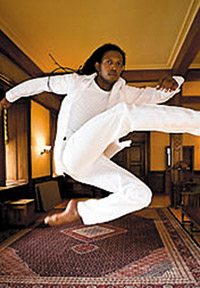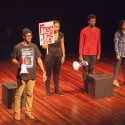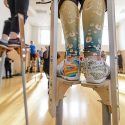Generation Dancing explores physical side of culture
A dance concert on Feb. 3–5 will explore the physical manifestations of culture and how experiences inform the physical self.

A dance concert on Feb. 3–5 premieres Chris Walker’s episodic work “E Pluribus Unum.”
The concert, Generation Dancing, furthers the idea as “an intergenerational dialogue through physical explorations of what is stored in the body,” says Chris Walker, choreographer and artistic director.
Coming from a Jamaican background, Walker’s natural perspective outlasted the narrow framework of the western-style curriculum under which he earned a master’s and bachelor’s of fine arts from the State University of New York. Early in his academic career he asked, “Do contemporary dance expressions need to look European to be legitimate?” Walker has since studied culture and performance to determine what is necessary “to articulate the realities of the groups that (he) is connected to.”
Using these educational contractions allowed Walker to give birth to NuMoRune. Originally titled “Voices,” the dance company began in 2004. Nearly seven years later, the company’s mission continues under a strategic name change; NuMoRune whose parts stand for New (Nu), Movement (Mo) and a narrative poem, song and verse distilled (Rune). The abridgement of this created word fits the community the company represents as he characterizes the traditional and contemporary Caribbean and North American urban culture to include the formation of new words and phrases.
NuMoRune advocates both of these communities that are underrepresented on the concert stage while distilling the universal concept of bodily habits, which he views as human responses to life.
The centerpiece of the concert is the premiere of Walker’s episodic work “E Pluribus Unum” which epitomizes these bodily uses in everyday life. One episode labeled “Backflip” deals with three young men of color and their reactions under societal expectations of what constitutes professional attire and physical relation.
The scope of struggle in the United States expands from the personal cases of three young men to the wider community of ethnic/ racial minorities and “alien” groups that receive poor treatment in airport security when attempting to enter the country. “Secondary Screening” is a piece that makes a democratic statement against this harassment for those who’ve pondered their rights as traveling citizens while sitting for hours in confinement of airport security. Inspired by Haile Selassie’s 1963 speech to the UN about unequal treatment of world citizens, Walker choreographs a narrative of citizens stuck in the secondary screening process, which parallels the war zone that the space transforms into.
“The People Who Came,” is a further exploration of immigration narratives to the United States. The choreography is framed around the distillation of migration experiences that come from the heritage of the dancers involved. The piece demonstrates how cultural backgrounds continue to inform us as individuals with the physical language based on a continued dialogue. The work is best defined as a large collaborative effort that incorporates dance from students and live music, song and spoken word from First Wave students.
Another episode, which features the fusion of spoken word poetry and contemporary dance, is “One & Two Gather.” Sofia Snow of First Wave delivers her poem “Angel Hair” to match a duet performed by Sarah Mitchell and Kit Stanley. Their movement blends to the poem of two women who migrated from different backgrounds, yet share the unconditional love of sisterhood.
FuturPoint Dance Co. concludes “E Pluribus Unum” with the premiere of Walker’s “Dubwise.” Just as dub music distills the rhythmic line of music to provide an instrumental remix, “Dubwise” epitomizes the process of preserving cultural identity represented as the rhythmic heartbeat. This cultural retention of self is demonstrated by a soloist moving irreverently to the quartet of dancers who shift throughout the performance.
The concert is scheduled for 8 p.m. on Thursday–Saturday, Feb. 3–5, at Margaret D’oubler Theater in Lathrop Hall. Ticket information is available through the box office at Memorial Union. There is a discussion with the performers at the end of the Feb. 3 performance and an informal reception after the Feb. 4 performance. There will also be free public dance classes hosted by guest artist Guy Thorne.


